Over the next couple of months on Read/WriteWeb, I’ll be profiling the main Web Office
suite candidates – such as Zoho, ThinkFree, gOffice, Zimbra, JotSpot, Goowy and Morfik.
Plus of course Microsoft’s Office Live and Google’s current jigsaw puzzle of Web Office
apps. Today I’m starting with Zimbra.
Zimbra is an open source Web Office vendor. It started
off in 2005 as an email/calendar collaboration toolset, big on mashup functionality and
Web 2.0 hype. Zimbra has since added word processor and spreadsheet to its product range,
meaning it now closely resembles a Web Office suite.
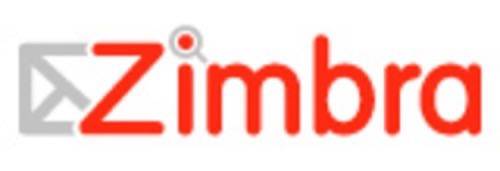
Zimbra Collaboration Suite (ZCS) 4.0 was launched last month, featuring
Zimbra Documents – a WYSIWYG tool for creating, sharing, and publishing word and
spreadsheet documents online. Other features in ZCS 4.0 include synch to mobile devices,
VoIP integration, user access controls. The ZCS 4.0 Open Source Edition of Zimbra is
free, and the commercially-supported Network Edition is $28/mailbox/year.
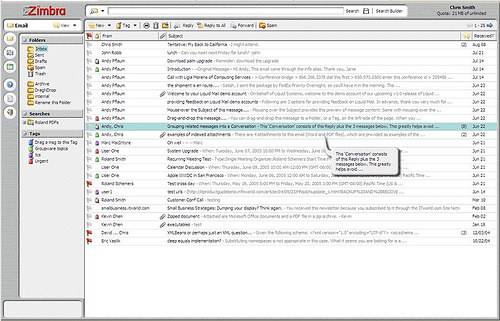
Product Review
The product is made up of a browser-based Ajax client and a “collaboration server”.
Alternatively you can just use the Zimbra server and pair it with another email client
such as Outlook or Thunderbird.
You can do a hosted demo
on their website, to get the feel of the product. If you decide to go ahead with it,
Zimbra is available as an open source
download or a hosted edition (both are browser-based).
The email part of Zimbra uses the same kind of interface as Outlook, but its
functionality is more along the lines of Gmail. For example it has a ‘conversation’ view
that organizes emails by conversation topic rather than a folder view.
Zimbra uses AJAX extensively, to make their
web email app look and feel like a desktop one. For example it uses mouseovers to show
metadata for items and words. This seems like a nice value-add, but it would mean
changing my own usage habits with email. – because generally I don’t think of it as a
browsing experience. But this is a plus in my book, because it shows Zimbra is
challenging the old Outlook-based email paradigm (which most other web email systems,
with the exception of Gmail, still follow). Drag and drop is another AJAX touch – users
can move their email messages from folder to folder this way.
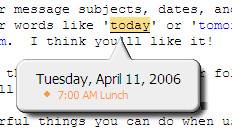
Drag and Drop
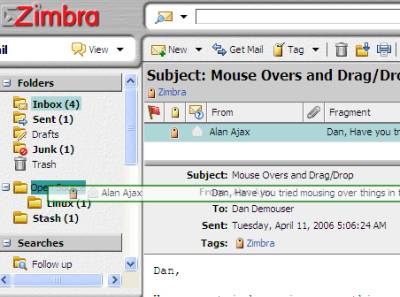
The Zimbra Mashup Experience
The real power of Zimbra is its APIs, which together with Zimbra’s open source status
makes this a potentially powerful development platform. The APIs enable developers to
access messaging functions inside the Zimbra application, meaning external apps can hook
into Zimbra’s functionality. The example used in the demo is a travel application using
Zimbra’s APIs to “automatically create a calendar event for the person traveling”. In
addition to the inward API hooks, Zimbra also has interfaces for making outbound web
service requests. Here’s the example used in the demo:
“…the Zimbra application could recognize a shipment tracking number such as
792806493888 [a Fedex Tracking Number] in a message, make a
web service call to the shipping vendor based on that number, and then provide more
details about the shipment to the recipient of the message based on information obtained
from the web service call.”
You can even set it up to interact with another web service, from within the Zimbra
system.
Zimbra Mashup
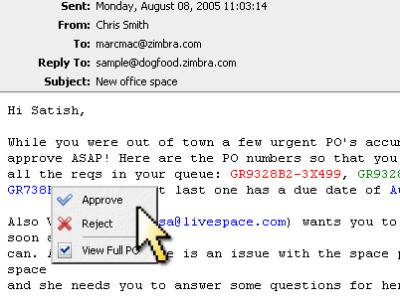
Another example is clicking on a link within an email and up pops a Yahoo! Map, or a
link when clicked opens a Skype call. Plus Zimbra has mini web apps embedded within its
system, called “Zimlets” – for example an Amazon search box. The buzz phrase for all this
is “enterprise mashups” and it’s the kind of functionality that got the
attendees of the last Web 2.0 Conference very excited back in
October.
Zimbra Maps mashup
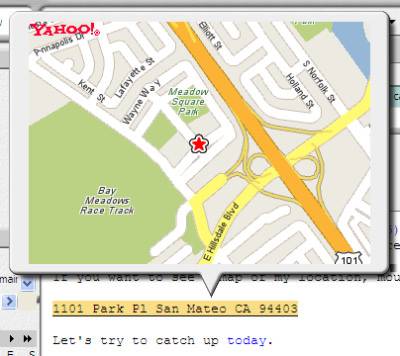
The APIs and web services possibilities that Zimbra offers seem like a potentially
thriving platform. So I guess the question is: are they being used?
Zimbra Documents
The addition of documents and spreadsheets to Zimbra’s arsenal made them a worthy
contender among the small ‘Web Office’ startups. Another exciting aspect of Zimbra
Documents is that it uses ALE (AJAX Linking and Embedding), which provides the ability to
embed rich content into an editable document that users can share, publish, and edit –
within a Web browser.
Performance issues?
There have been question marks about the performance of Zimbra in the browser, in
particular that the UI could be very slow. In May I asked CEO Satish Dharmaraj
about this. He acknowledged there have been issues with IE browsers, in particular IE6.
But Satish said that Zimbra performs significantly better in Firefox
and a lot of its UI problems in IE6 were due to Zimbra “pushing the envelope of Ajax”.
Apparently IE7 will address these issues, so Satish was confident (when I last spoke to
him) that Zimbra will not run into such problems in the new Microsoft browser.
Summary
Zimbra is packed full of features, such as the mashups and things like “Search
Builder” and an RSS reader. It’s an all-round impressive product. I’m not sure how much
it’s being used by external partners as a mashup platform though. But when I spoke to
Satish, he told me they have enterprise clients that are happily using Zimbra to
completely manage their communications online and collaborate. Zimbra is a small (20 people), well funded
startup ($31 million) – so it’s still young and growing. One to watch in the
Enterprise space.
Note: this post is adapted from my previous reviewsof Zimbra, and interview, on ZDNet.










